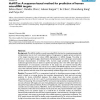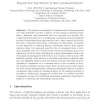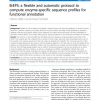171 search results - page 24 / 35 » Microarray-based gene set analysis: a comparison of current ... |
ALMOB
2008
13 years 7 months ago
2008
Background: MicroRNAs (miRs) are small noncoding RNAs that bind to complementary/partially complementary sites in the 3' untranslated regions of target genes to regulate prot...
ISBRA
2010
Springer
13 years 6 months ago
2010
Springer
The random accumulation of variations in the human genome over time implicitly encodes a history of how human populations have arisen, dispersed, and intermixed since we emerged as...
ALGORITHMICA
2006
13 years 7 months ago
2006
Phylogenetic analysis is an area of computational biology concerned with the reconstruction of evolutionary relationships between organisms, genes, and gene families. Maximum likel...
JCB
1998
13 years 7 months ago
1998
The function of an unknown biological sequence can often be accurately inferred by identifying sequences homologous to the original sequence. Given a query set of known homologs, ...
BMCBI
2010
13 years 4 months ago
2010
Background: Models for the simulation of metabolic networks require the accurate prediction of enzyme function. Based on a genomic sequence, enzymatic functions of gene products a...




